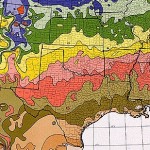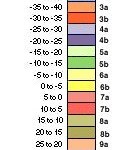San Antonio Express News
GARDENING, Etc.
Sunday, March 28, 2004
by Lynn Rawe, CEA-Horticulture
Improving the health of your landscape does not require any magical potions or mystical chants. Using good common sense and a few helpful hints, you can save money, water and maybe the life of your landscape.
If you are installing your own landscape, be sure you take into consideration plant selections. Become knowledgeable and choose those plants that are adapted to our soil and climate. Most of the soil in Bexar County is alkaline, so choosing acid loving plants such as azaleas may bring you headaches and frustration. Try to become familiar with “planting zones.” Bexar County is in Zone 8. If a plant has a zone classification of 4 to 7, chances are it may not be able to withstand the summer heat in our area.
Bexar County falls within two zones! Though it may be hard to see the detail on the map above, Bexar County is divided into Zone 8a and 8b.
| 1 | Below 1 | 7 | 61 to 90 |
| 2 | 1 to 7 | 8 | 91 to 120 |
| 3 | 8 to 14 | 9 | 121 to 150 |
| 4 | 15 to 30 | 10 | 151 to 180 |
| 5 | 31 to 45 | 11 | 180 to 210 |
| 6 | 46 to 60 | 12 | Above 210 |
Choosing plants that are drought and heat tolerant, and have a natural resistance to pests and diseases, can save water and result in a reduction in the amount of pesticides used. Check with the County Cooperative Extension office or a certified nurseryman if you need help with these choices.
Knowing how many hours of light a plant will receive in your landscape is also important in selecting plant material. Some plants will only survive in the shade while others may need partial shade or full sun. And a note about “fun sun.” Some people think that if the plant receives full sunshine at some time during the day, regardless of how long that might be, it can be called a “full sun” plant. WRONG! “Full sun” means that the plant requires at least six or more hours of direct sunlight each day. A word about the shaded areas: Although a blooming plant requiring more light, may grow in a semi-shaded area, it probably will not produce flowers, or if it does, the blooming will be sparse.
The use of mulch, because it helps to hold the moisture within the soil, will reduce the amount of water used. Mulch helps to protect the tender roots of the plant from the summer heat; and in the winter, mulch insulates the roots from cold. Mulch also reduces the spread of disease by reducing the splashing of water. Many diseases can be spread to the plant when water carrying fungal spores splashes onto the leaves.
Proper watering is very important to the life of a plant. Watering often and for short periods of time creates shallow root systems because the roots are constantly reaching for more water toward the soil surface. Plants with shallow roots are more susceptible to heat and freeze damage. Watering deeply and less frequently encourages deeper roots and healthier plants.
Have your soil tested to determine your lawn’s nutrient needs. A simple “soil test kit” is available at the Bexar County Cooperative Extension office. The homeowner should follow the directions on the instruction sheet, and place the soil sample within the furnished bag. The homeowner will mail the sample to the Texas A&M Soil Laboratory. You should receive your results within four to six weeks. The fees for this service vary depending upon the amount of detail desired. Please remember, that too much fertilizer is just as bad for your plants as too little. Even though most fertilizers should be lightly watered in, never fertilize your lawn if the weather forecast is calling for heavy rains-your dollars will just float away! Finally, use a “slow release” form of nitrogen so that the lawn will benefit over a longer period of time.
Watch your landscape carefully for insects and disease. Not all insects are bad (only 2-3% in fact!), so identify the bug and determine if it is actually causing damage. Do not use pesticides unless you need them. Only spray the plants that need to be treated, and remember to use the least toxic pesticide. That choice could be either an organic, or a synthetic chemical. Select the appropriate product for the problem, and always follow label directions exactly. There are people who believe that because they have a really bad infestation, they must add more product than the directions recommend. WRONG! Using common sense may not only save your landscape, but our environment as well. As you are the steward of your landscape, we all are the stewards of this good earth.
This article was written by Lynn Rawe, County Extension Agent-Horticulture for Texas Cooperative Extension in Bexar County.


